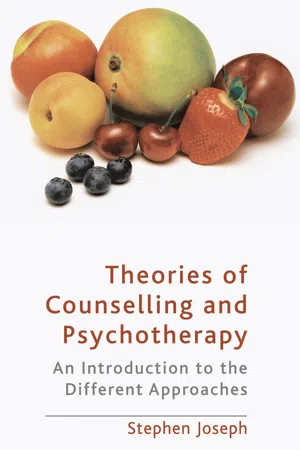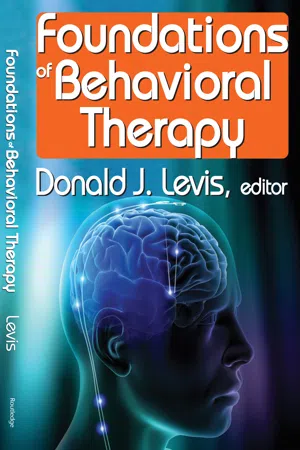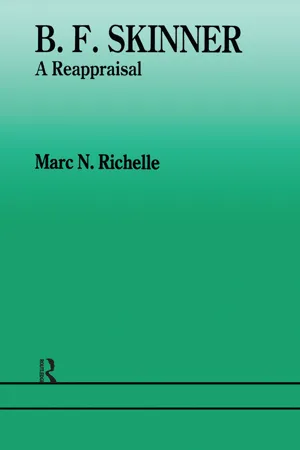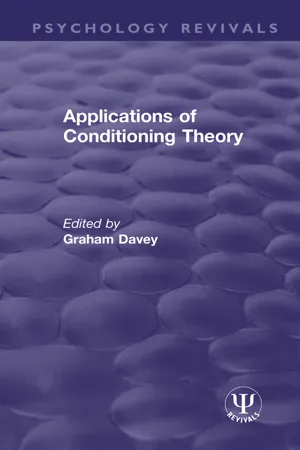Psychology
Ivan Pavlov
Ivan Pavlov was a Russian physiologist known for his pioneering work in classical conditioning. His famous experiment with dogs demonstrated how a neutral stimulus, such as a bell, could become associated with a reflex response, such as salivation, through repeated pairings. This research laid the foundation for the study of behavioral psychology and had a profound impact on our understanding of learning and behavior.
Written by Perlego with AI-assistance
Related key terms
8 Key excerpts on "Ivan Pavlov"
- eBook - ePub
Theories of Counselling and Psychotherapy
An Introduction to the Different Approaches
- Stephen Joseph(Author)
- 2010(Publication Date)
- Bloomsbury Academic(Publisher)
As we have seen in the previous chapter, the argument that there was a need for research into the effectiveness of psychotherapy and counselling came about in part because of criticisms of the psychodynamic model for its unscientific nature and lack of effectiveness as a therapeutic approach (Eysenck, 1952, 1965). In response to Eysenck’s criticisms of psychoanalysis, psychologists began to apply the principles of learning that had been discovered in the laboratory to clinical practice. In contrast to psychoanalysis, which focuses on the internal processes of the person, the behavioural model focuses on the environmental conditions that shape our behaviour. Theorists in the behavioural tradition have emphasized two types of conditioning: classical conditioning and operant conditioning. Ivan Pavlov and classical conditioning Ivan Pavlov (1849–1936), a Russian physiologist, is credited with the discovery of a process called classical conditioning (sometimes called Pavlovian conditioning). Essentially, this is a process of learning by temporal association. Simply, what this means is that if two events occur in close succession they become associated and eventually we come to respond to one as we do to the other. Pavlov (1928) came across this phenomenon while he was studying the digestive process in dogs. As part of his research the dogs were given a meat powder, and Pavlov noticed that after a while the dogs began to salivate when the researchers were about to feed them. Later, it was noticed that the dogs began to salivate when they heard the footsteps of the researchers coming to feed them - eBook - ePub
Theories of Development
Concepts and Applications
- William Crain(Author)
- 2015(Publication Date)
- Routledge(Publisher)
CHAPTER 8Learning Theory: Pavlov, Watson, and SkinnerWe have discussed theorists in the developmental tradition. These theorists believe that key developments are governed by internal forces—by biological maturation or by the individual’s own structuring of experience. In this and the following chapter, we will describe the work of some of the theorists in the opposing, Lockean tradition—learning theorists who emphasize the processes by which behavior is formed from the outside, by the external environment.PAVLOV AND CLASSICAL CONDITIONING
Biographical Introduction
The father of modern learning theory is Ivan Petrovich Pavlov (1849–1936). Pavlov was born in Ryazan, Russia, the son of a poor village priest. Pavlov himself planned to become a priest until the age of 21, when he decided he was more interested in a scientific career. For many years he devoted his attention to physiological investigations, and in 1904 he won the Nobel Prize for his work on the digestive system. It was just a little before this time, when Pavlov was 50 years old, that he began his famous work on conditioned reflexes. This new interest came about through an accidental discovery about the nature of salivation in dogs. Ordinarily dogs salivate when food touches their tongues; this is an innate reflex. But Pavlov noticed that his dogs also salivated before the food was in their mouths; they salivated when they saw the food coming, or even when they heard approaching footsteps. What had happened was that the reflex had become conditioned to new, formerly neutral stimuli.For a while Pavlov could not decide whether to pursue the implications of his new discovery or to continue with his earlier research. Finally, after a long struggle with himself, he began studying the conditioning process. Still, Pavlov believed that he was working as a physiologist, not a psychologist. In fact, Pavlov required that everyone in his laboratory use only physiological terms. If his assistants were caught using psychological language—referring, for example, to a dog’s feelings or knowledge—they were fined (R. Watson, 1968, pp. 408–412). - eBook - ePub
Learning & Behavior
Eighth Edition
- James E. Mazur(Author)
- 2016(Publication Date)
- Routledge(Publisher)
Chapter 3 Basic Principles of Classical ConditioningLearning ObjectivesAfter reading this chapter, you should be able to- describe the procedure of classical conditioning and some of the most common ways it is studied in the laboratory
- explain Pavlov’s stimulus substitution theory, and describe its strengths and weaknesses
- describe the basic principles of classical conditioning, including acquisition, extinction, spontaneous recovery, conditioned inhibition, generalization, and discrimination
- explain how the timing of the stimuli in classical conditioning affects the results
- give examples of classical conditioning that are found in everyday life
- describe some behavior therapies that are based on classical conditioning, and evaluate their effectiveness
Pavlov’s Discovery and Its Impact
The Russian scientist Ivan Pavlov is one of the most famous figures in the history of psychology. Pavlov was interested in the various substances secreted by an animal’s digestive system to break down the food eaten, including saliva. He used dogs in his research, and he developed a surgical technique that enabled him to redirect the saliva from one of the dog’s salivary ducts through a tube and out of the mouth, so that it could be measured (see Figure 3.1 ). A dog might receive several test sessions on successive days. In each session the animal would be given food, and its salivation would be recorded as it ate. Pavlov’s important observation came when studying dogs that had been through the testing procedure several times. Unlike a new dog, an experienced one would begin to salivate even before the food was presented. Pavlov reasoned that some stimuli that always preceded the presentation of food, such as the sight of the experimenter, had developed the ability to elicit the response of salivation. Pavlov concluded that his dogs were exhibiting a simple type of learning: Salivation, which began as a reflexive response to the stimulus of food in the dog’s mouth, was now elicited by a new stimulus. This phenomenon is now known as classical conditioning - eBook - ePub
- Donald Levis(Author)
- 2017(Publication Date)
- Routledge(Publisher)
thought of it.” As part of his lecture series in Paris around 1855, Claude Bernard described the experimental demonstration of salivary conditioning in the horse under controlled conditions (see Rosenzweig, 1959). However, the difference between the reports of Pavlov and most of his predecessors in conditioning is crucial. Whereas virtually all earlier investigators confined their endeavors to the sporadic demonstration of already established conditional responses, Pavlov was one of the first to initiate a program of investigation that included the systematic study of the formation and extinction of new and deliberately induced conditional reflexes.If any one scientist can be singled out for his influence upon Pavlov, it is Sechenov, the father of Russian physiology and the discoverer of the phenomenon of central inhibition (and, incidentally, a student of Bernard, whose interest in the process of conditioning has been mentioned above). Like many of his predecessors who had thought about the nature of acquired associations, Sechenov was a convinced monist and materialist. But just as Pavlov was later to continue the line of thought of earlier observers of conditioning, but with the key difference already noted—so Sechenov, by his practical investigations of the phenomenon of central inhibition, was among the first to replace philosophical deliberation and incidental observation with experimentation. As is well known, this course steered him into trouble with the tzarist government, culminating in a clash with the censor over the proposed title of his now famous monograph. Sechenov was forced to relinquish the more revealing–and therefore, from the censor’s point of view, more dangerously “antireligious” -An Attempt to Establish the Physiological Bases of Psychical Phenomena in favor of the safer and more prosaic Reflexes of the Brain, - eBook - ePub
- Marc N. Richelle(Author)
- 2016(Publication Date)
- Psychology Press(Publisher)
II Skinner and the European Tradition: Pavlov, Freud, Lorenz and PiagetPassage contains an image
4 Pavlov’s Ambiguous Heritage
DOI: 10.4324/9781315784977-4An Unfortunate Misnaming
The use of the same term conditioning to designate the behavioural phenomenon involved in Skinner’s procedure and the type of association described earlier by Pavlov, has had unfortunate consequences. In the language of the layman, and sometimes in the psychologist’s use, conditioning evokes a very simple, mechanistic type of learning, possibly at work in elementary activities of animals, but of little importance in human actions. Moreover, it has a connotation of forced control over behaviour, the organism submitting passively to the will of the experimenter. It is even often felt that conditioning is an artificial phenomenon, born from the perverse manipulation of animals’ behaviour by scientists in their laboratory, but with little if any relevance to real life. All this is equally applied to Pavlovian conditioning as well as to the operant conditioning described by Skinner. It is a serious confusion, however, that requires some clarification, since for Skinner operant conditioning was something totally different from Pavlovian conditioning. This is not to say that the connotations of the word, as summarised here, correctly apply to Pavlovian conditioning, but that what Pavlov has studied pertains to a level quite distinct from and far more elementary than what Skinner has analysed.Pavlov’s model is well known from his classical experiment on the salivary reaction in dogs. In the procedure used by Pavlov, salivation was shifted from food, its natural eliciting stimulus—or unconditioned stimulus—to the sound of a bell, an initially neutral event with respect to salivation, eventually changed, through association, to the status of conditioned - eBook - ePub
A History of Psychology
Globalization, Ideas, and Applications
- Robert B. Lawson, E. Doris Anderson, Antonio Cepeda-Benito(Authors)
- 2017(Publication Date)
- Routledge(Publisher)
Petersburg in 1870. Pavlov earned his MD in 1883 and his career leapt forward when he was appointed to the chair of pharmacology at the St. Petersburg Military Academy in 1891, where he organized the Institute of Experimental Medicine in St. Petersburg. Thereafter, he was appointed professor of physiology at the University of St. Petersburg in 1895. Pavlov (1902/1897) was awarded the Nobel Prize in physiology for his Lectures on the Work of the Digestive Glands, and finally in 1907 was elected a full member of the Russian Academy of Science. (See Chapter 16 for further details about I. P. Pavlov.) Basic Pavlovian Conditioning For his Nobel Prize address, Pavlov, rather than describe his research on the digestive tract, for which he was awarded the prize, focused upon his latest work on what he called psychical stimuli. Pavlov came to realize through his studies concerning the pairing of neutral stimuli with feeding that he was working with two types of salivary reflexes, both of which were caused by physiological responses of the nervous system. The foundational physiological response was the unconditioned response (UCR) caused by the natural stimulation of the oral cavity. The second reflex, conditioned responses (CR), could activate areas other than the oral cavities (i.e., eyes, ears, and/or nose; Pavlov, 1955). The next step was to explain the relationship between the two types of responses. He described the paradigm in terms of an unconditioned stimulus (US), a biological stimulus that has the capacity to elicit automatically a reflex activity that yields the UCR, whereas a conditioned stimulus (CS) is a stimulus that was at one time a neutral stimulus but through repeated pairings with the US elicits a CR similar to the UCR - eBook - ePub
- Graham Davey(Author)
- 2017(Publication Date)
- Routledge(Publisher)
6 Pavlovian principles and behaviour therapyGlyn Thomas and Mark O'CallaghanIn the early years of the present century, J.B. Watson claimed that human behaviour was nothing more than long sequences of conditioned reflexes. Fifty years on, W.F. Brewer (1974) felt able to argue that there was no convincing evidence for classical conditioning in adult humans.The present chapter attempts to trace the fluctuating fortunes of Pavlovian (classical) conditioning as a model for analysis and treatment in clinical settings (behaviour therapy). Firstly, we provide a brief historical survey of clinical applications of Pavlovian conditioning. Secondly, taking the treatment of fear and anxiety as an illustration, we evaluate the clinical success of these applications. Finally, we attempt to relate current practices of behaviour therapy to recent theories of Pavlovian conditioning.Historical survey
Experimentally, Pavlovian conditioning is achieved by pairing two stimuli without regard to the subject's behaviour. We can illustrate this procedure with Watson and Rayner's (1920) classic study of conditioned fear in a human infant (Little Albert). At the time of the study, Albert was eleven months old. Earlier, when he was presented with a white rat he showed no sign of fear. After seven pairings of the rat (conditioned stimulus) with a distressingly loud noise (unconditioned stimulus), Albert showed clear signs of fear when the white rat was presented alone. Watson and Rayner (1920) interpreted this result as a clear demonstration of the process by which fears of specific objects (phobias) are learned in everyday circumstances.Experiments which have attempted to repeat Watson and Rayner's demonstration have met with varying success. Whatever the status of its empirical support Watson and Rayner's study has become an influential legend in the history of clinical psychology; that the development of emotional responses can be represented in terms of Pavlovian principles. - eBook - ePub
- Gregory A. Kimble, Michael Wertheimer, Charlotte L. White(Authors)
- 2014(Publication Date)
- Psychology Press(Publisher)
*Photograph of Ivan Petrovich Pavlov courtesy of the National Library of Medicine, Bethesda, Maryland.Chapter 3 THE SPIRIT OF IVAN PETROVICH PAVLOV Gregory A. KimbleFor the sake of the conversation to follow, please let me present academician Pavlov in a role that he would certainly reject, even for the light-hearted purposes of this occasion. Imagine that his ghost is an observer here at this convention, his presence motivated out of curiosity: has psychology managed to become a science since the 1920s, when he became interested in the problems of psychology, but was repelled by the kind of thinking that he found in the field? To help you get the spirit of his opinion, let us listen to the ghost of Pavlov speaking for himself.1Regularly, from 1921 until the day I died, I held a series of laboratory meetings, known as my “Wednesdays.” At these meetings I often spoke quite bluntly on many topics, including the psychologists. I had no respect for most of them. On one of those occasions I made remarks like these: I have gone back to the grudge that I had against the psychologists. At first I renounced them, then I became reconciled with them to a degree, but now the facts have turned me against them once more. They apparently want their subject to remain forever unexplained. How they love the mysterious! Everything that can be explained physiologically they reject (Pavlov, 1955, p. 554). It is clear to me that they jealously protect the behavior of animals and men from physiological explanations. They constantly ignore such explanations and do not try to apply any of them in an objective way (pp. 442–443).2I suspect that this rejection of physiology was related to the fact that most psychologists prefer words to explanations. More than once, I criticized that kind of silliness; for example, now gentlemen, let us turn to the psychologists. They are, assuredly, experts at playing with the language but they fully disregard the facts. They amuse themselves with words, but they ignore reality. They are an exceptional type of thinking people. This is absolutely clear (pp. 571, 611).
Learn about this page
Index pages curate the most relevant extracts from our library of academic textbooks. They’ve been created using an in-house natural language model (NLM), each adding context and meaning to key research topics.







